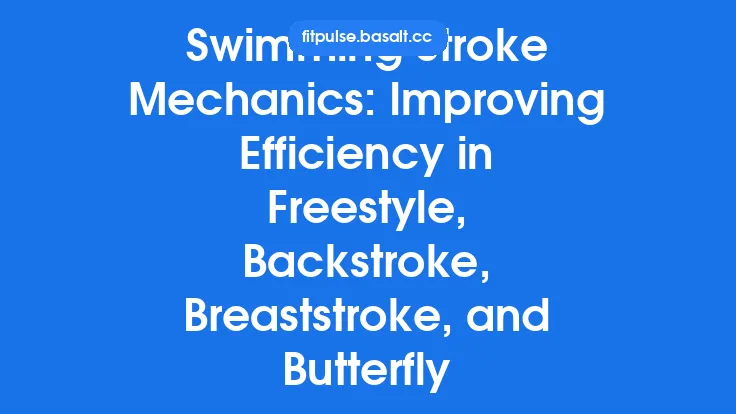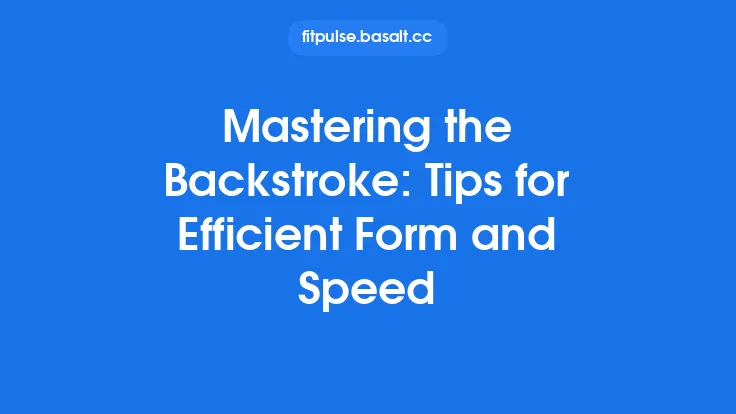Improving turn efficiency is one of the most impactful ways to shave seconds off race times, especially in short‑course pools where turns can account for a substantial portion of the total distance. While many swimmers focus heavily on stroke mechanics and conditioning, mastering the nuances of both flip turns and open turns can provide a decisive edge. Below is a comprehensive guide that breaks down the biomechanics, technique cues, drills, and practical integration strategies for executing faster, more efficient turns.
Understanding the Mechanics of Flip Turns
A flip turn is essentially a rapid, inverted somersault performed at the wall, allowing the swimmer to maintain forward momentum with minimal loss of speed. The key mechanical phases are:
- Approach – The swimmer maintains a strong, streamlined glide as they near the wall, typically 2–3 meters out. Stroke rate may increase slightly to set up the turn without sacrificing speed.
- Rotation Initiation – The head leads the rotation; a quick chin‑tuck combined with a strong hip snap initiates the somersault. The shoulders follow, creating a tight, compact shape.
- Wall Contact – The feet make contact with the wall just before the body completes the rotation. Ideally, the toes are pointed, and the knees are slightly flexed to absorb impact while preserving a streamlined posture.
- Push‑off – The swimmer extends the legs forcefully, generating a powerful push that propels them into a tight streamline. The arms extend forward, and the head remains in line with the spine.
- Underwater Glide – A brief, high‑velocity glide follows the push‑off, during which the swimmer initiates the first dolphin kick (or flutter kick, depending on the stroke) to maintain speed before surfacing.
The physics behind a flip turn revolve around conserving angular momentum and converting the kinetic energy of the approach into a forward thrust. By minimizing the time spent rotating and maximizing the push‑off force, swimmers can preserve a larger proportion of their pre‑turn velocity.
Open Turn Fundamentals
Open turns are typically used in breaststroke and butterfly, though they can appear in freestyle or backstroke when a swimmer prefers a more controlled wall approach. The sequence includes:
- Approach – The swimmer slows slightly to position themselves correctly for the turn, often using a final stroke to set up the body angle.
- Touch – One hand (or both, depending on the stroke) contacts the wall while the body remains relatively upright.
- Pivot – The swimmer rotates the body away from the wall, using the planted hand(s) as a fulcrum. The hips and shoulders turn in unison, creating a smooth, low‑profile pivot.
- Leg Recovery – The legs are drawn up and then extended outward, preparing for a strong push‑off.
- Push‑off – The feet press firmly against the wall, and the swimmer launches into a streamlined glide, often accompanied by a dolphin or breaststroke kick.
Open turns rely heavily on precise hand placement and a controlled pivot to avoid excessive drag. The goal is to transition from the touch to the push‑off as quickly as possible while maintaining a tight body line.
Key Differences Between Flip and Open Turns
| Aspect | Flip Turn | Open Turn |
|---|---|---|
| Typical Strokes | Freestyle, Backstroke | Breaststroke, Butterfly (occasionally freestyle) |
| Body Position | Inverted, compact somersault | Upright or slightly inclined, hand‑touch pivot |
| Wall Contact | Feet only, just before rotation completes | Hands (or both hands) first, then feet |
| Rotation | Rapid 360° rotation | Minimal rotation, pivot around hand(s) |
| Push‑off Mechanics | Strong leg extension from a tucked position | Leg extension after a more extended body posture |
| Speed Preservation | Higher potential for maintaining velocity due to continuous forward momentum | Slightly more speed loss due to deceleration before touch |
Understanding these distinctions helps swimmers decide which turn type best suits their stroke and race strategy.
Optimizing Body Position and Streamline
A streamlined body reduces drag dramatically. Whether executing a flip or open turn, the following cues are essential:
- Head Alignment: Keep the head in line with the spine; avoid looking up or down during the rotation. In a flip turn, the chin should be tucked toward the chest; in an open turn, the head should stay low as the body pivots.
- Arm Placement: After the push‑off, extend the arms fully forward, squeezing the hands together. This creates a narrow frontal area.
- Leg Extension: Fully extend the knees and ankles at the moment of push‑off. Pointed toes help channel the force directly forward.
- Core Engagement: A tight core stabilizes the body, preventing wobble that can increase drag during the underwater glide.
Practicing these positions in isolation—such as “streamline holds” on the wall—helps develop muscle memory for race conditions.
Foot Placement and Wall Contact
The exact spot where the feet meet the wall can influence the push‑off angle and, consequently, the speed of the subsequent glide.
- Flip Turns: Aim to contact the wall with the balls of the feet, just before the hips complete the rotation. This timing ensures the legs are already primed for extension, allowing a seamless transition from rotation to push‑off.
- Open Turns: After the hand touch, bring the knees up and position the feet shoulder‑width apart, with the toes pointed. The push‑off should be performed from a slightly flexed knee position (about 30–45°) to maximize force generation.
Swimmers can use a “wall marker” (a small, non‑intrusive tape or a colored tile) to practice consistent foot placement during drills.
Timing and Rhythm
Efficient turns are not just about technique; they are about timing the sequence to the swimmer’s stroke rhythm.
- Stroke Count to Wall: Determine the optimal number of strokes before the wall for each event. For example, a 25‑yard freestyle sprint may require a 2‑stroke approach, while a 100‑yard race may allow a 3‑stroke approach.
- Turn Initiation Cue: Use a visual cue (e.g., the lane line) or a count of strokes to trigger the rotation or hand touch. Consistency in this cue reduces hesitation and improves overall turn speed.
- Underwater Phase: After the push‑off, maintain a steady kick tempo (usually 2–3 kicks per second) to sustain velocity until the breakout. The transition from glide to kick should be smooth, avoiding abrupt changes that can increase drag.
Drills to Enhance Turn Speed
- Wall Slides (Flip Turn)
- Start in a streamline, place the hands on the wall, and slide forward while maintaining a tight body line. This drill reinforces the feel of a fast push‑off and encourages proper foot placement.
- Half‑Turn Flip
- Perform a 180° somersault at the wall, then push off. This isolates the rotation component, allowing swimmers to focus on a quick, tight flip without the full 360° motion.
- Open Turn Hand‑Touch Repetitions
- Practice the hand‑touch and pivot without a push‑off. Emphasize a quick, clean pivot and immediate leg recovery.
- Push‑Off Power Sets
- From a stationary position at the wall, execute a series of explosive push‑offs, holding each streamline for 5–7 seconds. This builds leg strength and reinforces the feel of a powerful launch.
- Timed Turn Intervals
- Swim a set distance (e.g., 25 m) focusing solely on the turn. Use a stopwatch to record the time from the last stroke before the wall to the breakout. Repeat, aiming to reduce the interval by 0.1–0.2 seconds each set.
- Underwater Dolphin Kick Integration
- After the push‑off, perform a prescribed number of dolphin kicks (e.g., 3–5) before surfacing. This drill links the turn to the underwater phase, ensuring a seamless transition.
Consistent repetition of these drills, combined with feedback, leads to measurable improvements in turn speed.
Video Analysis and Feedback
Modern coaching often incorporates video to pinpoint subtle inefficiencies. When reviewing turn footage:
- Frame Rate: Use a camera capable of at least 120 fps to capture the rapid rotation.
- Angles: Record from the side (to see body alignment) and from above (to observe foot placement).
- Key Frames: Identify the moment of wall contact, the peak of rotation, and the instant of push‑off. Compare these frames to an “ideal” model.
- Metrics: Measure the time between wall contact and breakout, the angle of the body at push‑off, and the distance traveled during the underwater glide.
Providing swimmers with visual evidence of their technique accelerates learning, as they can directly see the cause‑and‑effect relationship between small adjustments and performance gains.
Common Mistakes and How to Fix Them
| Mistake | Effect on Performance | Correction |
|---|---|---|
| Late foot contact (flip turn) | Loss of momentum, longer rotation time | Practice “feet‑first” drills; use a wall marker to cue earlier contact. |
| Head lifts too early | Increases drag, disrupts streamline | Keep chin tucked; focus on a “look at the ceiling” cue only after the push‑off. |
| Hands too far from wall (open turn) | Slower pivot, reduced push‑off force | Emphasize a tight hand‑touch; use a tactile cue (e.g., a small rubber pad) to feel proper placement. |
| Insufficient leg extension | Weak push‑off, reduced glide distance | Perform “push‑off power sets” focusing on full ankle plantarflexion. |
| Excessive rotation (flip turn) | Over‑rotation leads to loss of direction | Use a “half‑turn” drill to develop a compact rotation; count the number of somersaults in a set. |
| Delayed underwater kick | Speed drops during glide | Integrate a “kick‑on‑push” cue; count “one‑two” immediately after the push‑off. |
Addressing these errors early prevents the formation of bad habits that are harder to correct later.
Integrating Turns into Practice Sets
To ensure turn proficiency translates to race conditions, incorporate them deliberately into training:
- Turn‑Focused Sets: Example – 8 × 25 m freestyle with a flip turn on every lap, 30 seconds rest. Emphasize speed on the turn rather than overall pace.
- Mixed‑Stroke Turns: Alternate between flip and open turns within a set (e.g., 4 × 25 m freestyle, 4 × 25 m breaststroke) to reinforce adaptability.
- Breakout Timing Drills: Swim 50 m with a turn, counting the exact number of strokes from push‑off to surface; aim for consistency across repetitions.
- Race‑Simulation Sets: Include the same number of turns as the target event (e.g., 200 m freestyle with 7 turns) at race pace, focusing on maintaining stroke efficiency through each turn.
By embedding turn work into regular workouts, swimmers develop the endurance and muscle memory needed for high‑pressure competition.
Advanced Turn Variations and When to Use Them
- Backstroke Flip Turn with a Dolphin Kick
- Useful in short‑course backstroke where a quick, powerful push‑off can offset the slower backstroke start. The swimmer rotates onto the stomach, performs a flip, and adds a dolphin kick before surfacing.
- Open Turn with a “Touch‑and‑Go” in Breaststroke
- In sprint breaststroke, some elite swimmers execute a rapid hand touch followed immediately by a push‑off without a prolonged glide, minimizing time at the wall.
- Hybrid Turn (Freestyle/Butterfly)
- A hybrid combines a brief somersault (like a flip) with a hand touch, allowing swimmers who struggle with a full flip to still gain a quick pivot. This is often employed by younger swimmers still mastering the full rotation.
Choosing the appropriate variation depends on the swimmer’s comfort, the stroke’s rules (e.g., a legal butterfly turn must involve a simultaneous two‑hand touch), and the race distance.
Mental Cueing and Race‑Day Execution
Even the most technically sound turn can falter under pressure if the swimmer’s focus drifts. Effective mental strategies include:
- Pre‑Turn Visualization: Before the race, picture the exact sequence—approach, rotation, push‑off, glide. This mental rehearsal primes the neuromuscular system.
- Cue Words: Use short, actionable phrases such as “tuck,” “push,” or “streamline” spoken silently during the approach.
- Breathing Control: In short‑course events, many swimmers exhale just before the turn to avoid a gasp that could disrupt timing.
- Post‑Turn Reset: After the breakout, quickly refocus on stroke rhythm, treating the turn as a separate “mini‑race” within the larger event.
Embedding these cues into regular practice ensures they become automatic during competition.
Bottom Line
Turn efficiency is a blend of physics, biomechanics, and precise motor control. By dissecting the mechanics of flip turns and open turns, fine‑tuning body position, mastering foot placement, and integrating targeted drills, swimmers can consistently reduce turn time and gain a competitive advantage. Continuous video feedback, deliberate practice sets, and mental cueing round out a comprehensive approach that transforms turns from a necessary component into a performance‑enhancing asset.





